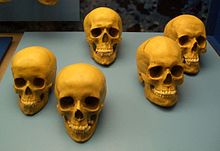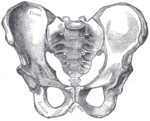Man
![]()
This article is about people of male gender - for other meanings, see Man (disambiguation).
The word man refers to a male adult human being and in the original sense refers to the biological sex, in modern usage also to gender identity, for example in the case of transgender persons who identify as men (compare gender). Male children and adolescents are referred to as boys (also Knaben, Buben). The polite form of address for a man in German is Herr, followed by the surname of the person addressed; accordingly, in some sports a distinction is made between "ladies' and men's sports".
The development of the biological sex is genetically determined by a pair of chromosomes XY, whereby the development of male primary and secondary sexual characteristics is controlled primarily by the Y chromosome and the male sex hormone testosterone. Men produce sperm that can be used to fertilize eggs. They are unable to become pregnant at any stage of their lives, unlike women with typical genetic development. In addition, there are transgender men whose gender identity differs from the sex assigned to them at birth, as well as intersex individuals with sexual characteristics that do not conform to the gender-ordering distinction of "man" or "woman".
Because of the fundamental influences of gender on human society, the term man is laden with many other interrelated and sometimes highly emotive meanings (see also masculinity). As a symbol for man, the male gender and masculinity, the symbol of Mars ♂ is commonly used (a shield with a spear).

Compilation Of 20 Male Portraits
Etymology
The gemeingerm. word mhd., ahd. man goes back to idg. manu- or monu- "man, man". What conception underlies this naming of man cannot be clarified with certainty.
Biological and medical characteristics
→ Main article: Human sex differences
Genetic characteristics
From a molecular biological point of view, man differs from woman by the chromosome pair XY (but see also XX-man) in the sex chromosomes (instead of XX in woman, but see also XY-woman). This difference leads to a sexual dimorphism. Due to the coincidence of an X chromosome from the maternal side (ovum) and a Y chromosome from the paternal side (sperm) in the zygote, this dimorphism arises in relation to the formation of the sex organs already during embryonic development. Males therefore usually have one X chromosome and one Y chromosome in their chromosome set. The latter contains a region called the sex determining region of Y (SRY), which in males is responsible for the embryonic production of the testis determining factor (TDF), a protein. If TDF is produced, male characteristics are formed; if it is missing, female characteristics are formed.
Morphological and physiological characteristics
Men differ physically from women by the different primary and secondary sexual characteristics. The construction of the primary sexual characteristics is mainly due to their function in reproduction. These are mainly
- the presence of male gonads, the testes, in which the male gametes, the sperm, are produced.
- the development of the primary sexual characteristics penis and scrotum in the human embryo.
- the development of secondary sexual characteristics during puberty, such as beard growth, a deeper voice than the female, broader shoulders, a narrower pelvis, a lower body fat and higher percentage of muscle in the total weight, a higher growth as well as generally stronger body hair, all of which are the result of a higher level of the male sex hormone testosterone in the blood.
For missing sex characteristics and multisexuality, see intersexuality and transgender.
Skeleton
Female and male pelvises differ. The hip bone hole in females has an oval shape, and the pelvic scoops are wider. The male pelvis, on the other hand, tends to be high, narrow and tight. The most important feature to distinguish is the angle of the pubic symphysis. It is greater than 90° in the female pelvis and less than 90° in the male.
Likewise, the skull shapes differ. Only male skulls have a clearly pronounced bulge above the eyes.
The finger proportions of men and women are different. For most men, the ring finger is longer than their index finger. In women, on the other hand, the index finger is longer than the ring finger, or at least the same length. A common hypothesis sees the cause for the different finger length ratio in the testosterone level in the womb.
Men's skin
The appearance of male skin (oilier and with larger pores than female skin) is mainly influenced by hormonal skin differences, e.g. skin thickness and increased sebaceous gland secretion.
The thicker male skin has a higher water-binding capacity, which makes the skin look tighter and firmer. The increased sebum production is responsible for a sufficient amount of moisture in the skin and for the composition of the so-called hydrolipid film. This film regulates the water content of the deeper layers, inhibits dehydration and gives the skin a smooth, supple appearance.
In addition, men's skin has a lower tendency to wrinkle. Wrinkles usually appear later in men than in women and also not as small creases, but more as deep ("prominent") wrinkles.
As a result of increased sebum production, blackheads and acne can occur more often, especially in young men. These occur when the sebum, together with dead skin cells, clings to the pores. An irritation of the blackheads leads to the settlement of germs and inflammatory pimples.
Andrology
The branch of medicine that deals with male diseases is called andrology. In general, men can be affected by the same diseases as women, but some gender-specific diseases also exist; for some other diseases, women and men show significantly different disease distributions (for example, for red-green vision impairment and other X-linked hereditary diseases).

Left two female skulls, right three male skulls

Male pelvis

A shaved, unclothed man in standard anatomical position

karyogram of a male
Questions and Answers
Q: What is a man?
A: A man is an adult male human being.
Q: How is the concept of a man related to gender?
A: The word "man" is commonly used to refer to male gender.
Q: What is manhood?
A: Manhood is the stage in a male's life after he transitions from being a boy.
Q: What distinguishes a boy from a girl?
A: A boy is a male child, and a girl is a female child.
Q: What are the genetic contributors to male characteristics?
A: A man inherits an X chromosome from his mother and a Y chromosome from his father.
Q: What is the men's rights movement?
A: The men's rights movement is a group that advocates for men's rights and opposes misandry.
Q: What is the term used to refer to a person who transitions to male gender?
A: A person who changes gender to male is also called a man.
Search within the encyclopedia